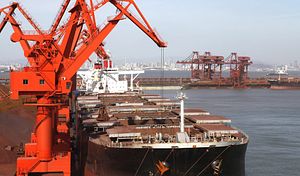Cheaper oil and easy money has aided global recovery, but the world is not out of the woods yet, the OECD has warned.
On Wednesday, the OECD’s latest Interim Economic Assessment pointed to only a “modest” near-term global expansion, “with abnormally low inflation and interest rates pointing to risks of financial instability.”
According to the Paris-based international economic organization, strong domestic demand has spurred growth in the United States, which combined with an appreciating U.S. dollar has added to demand growth in the rest of the world.
The world’s biggest economy is expected to expand by 3.1 percent this year and 3 percent in 2016, unchanged from the OECD’s November 2014 forecasts. Across the Atlantic, the Eurozone should benefit from low oil prices, monetary stimulus and a cheap euro to expand by 1.4 percent in 2015 and 2 percent next year, both 0.3 percentage point higher than previous estimates.
In Asia, China is projected to grow by 7 percent this year, in line with Beijing’s new target, but is seen slowing to 6.9 percent in 2016. According to the OECD, private demand growth in the world’s second-biggest economy has slowed as its economy “rebalances,” reflecting weakness in the property sector, with inflation set to stay weak due to lower commodity prices and reduced growth.
“Policymakers face a significant challenge as they seek to meet growth targets while also rebalancing the economy toward domestic demand and at the same time addressing financial risks,” the OECD said, warning that further stimulus should be “carefully calibrated.”
“Progress on reforms in a range of structural policy areas is needed to ensure sustainable rapid growth. Service sector liberalization would provide a powerful driver to growth and jobs and help the economy rebalance towards more domestic sources,” it added.
However, the OECD was more upbeat on Japan, raising its forecasts for economic growth to 1 percent this year and 1.4 percent in 2016, up 0.2 and 0.4 percentage point on its November forecasts, respectively. It pointed to a pickup in consumer spending and business investment in the world’s third-largest economy, with demand benefitting from cheaper oil, fiscal stimulus and continued monetary easing.
Nevertheless, the OECD said the current annual wage bargaining round was critical in determining “satisfactory demand growth and inflation close to the official target,” with positive inflation key to boosting nominal GDP growth and reducing the public debt burden.
“Progress on the ‘third arrow’ of structural reform has already been made, but greater ambition is required,” the OECD said, urging further structural reforms to boost competition, trade and labor force participation.
The economic organization also hiked its forecasts for India, which is expected to outpace China to become the world’s fastest-growing major economy in 2015-16. The OECD said Asia’s third-biggest economy would post 7.7 percent growth in 2015 and 8 percent next year, up 1.3 and 1.4 percentage point on its November forecasts, respectively.
Yet despite its bullishness, the OECD warned of “obstacles emerging to the adoption of growth-friendly structural reforms,” making maintaining rapid growth a “difficult challenge” for the reformist Modi government.
The worst news was reserved for commodity exporters such as Brazil and Canada, with falling prices of oil, coal, metals and some agricultural commodities dampening the prospects of such countries, including Australia. Australia’s Department of Industry recently cut its iron ore forecast by another 5 percent, with a continued weak outlook seen for commodities including coal and oil.
The OECD also warned of “growing risks associated with abnormally low nominal interest rates,” amid evidence of “mispricing of risk” in bond and equity markets.
“Lower oil prices and widespread monetary easing have brought the world economy to a turning point, with the potential for the acceleration of growth that has been needed in many countries,” OECD chief economist Catherine L. Mann said in a statement.
“There is no room for complacency, however, as excessive reliance on monetary policy alone is building up financial risks, while not yet reviving business investment. A more balanced policy approach is needed, making full use of fiscal and structural reforms, as well as monetary policy, to ensure sustainable growth and public finances over the longer term.”
Amid growing concern in Asia over the U.S. Federal Reserve’s planned interest rate hike, the OECD called on the Fed to “wait longer” before acting, citing the economic benefit of lower oil prices and the dollar’s recent appreciation.
According to Bloomberg News, Singapore’s dollar is seen as a proxy for investors’ view on Asia, and its 4.4 percent slide against the U.S. dollar in 2015 reflects worries that “Asia may struggle to withstand an interest-rate increase this year from the Federal Reserve.”
In more encouraging signs for Asia, investment bank Morgan Stanley has reportedly dropped India and Indonesia from its infamous list of the “Fragile Five” economies most at risk from the Fed’s policy change.
On Wednesday, the Fed surprised financial markets by taking a more cautious tone in its statement, noting that economic growth had “moderated somewhat” since its previous meeting in January. While it removed the word “patience” concerning returning to a “normal” policy, it reduced its inflation outlook and projected interest rate growth.
With a soft world economy, escalating financial risks, and the growing threat of deflation, Asia will be hoping the Fed stays patient for some time to come.

































